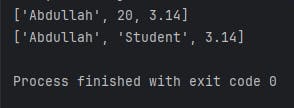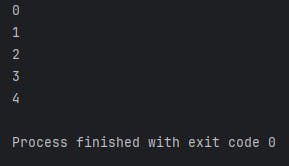Table of contents
List:
In Python, a list is a collection of items that can hold different data types, such as integers, strings, or even other lists. Lists are ordered, mutable (modifiable), and allow duplicate elements.
Syntax:
my_list = [element1, element2, element3, ...]
Creating a List:
# Creating a list of integers
nums = [1, 2, 3, 4, 5]
# Creating a list of strings
names = ['Abdullah', 'Ali', 'Bilal']
# Creating a mixed-type list
info = [20, 'Abdulah', 2.57, True]
Accessing Elements:
nums = [1, 2, 3, 4, 5]
names = ['Abdullah', 'Ali', 'Bilal']
info = [20, 'Abdulah', 2.57, True]
print(nums[0])
print(names[2])
print(info[3])
We can access the elements in the list by their index number. The first element in the list has the index 0.
Output:

Modifying Elements:
info = ['Abdullah', 20, 3.14]
print(info)
info[1] = 'Student'
print(info)
We can modify an element at our specified index number. info[1] = 'Student' means that modify the element present at index 1 with new element Student.
Output:

List Slicing:
numbers = [1, 2, 3, 4, 5]
print(numbers[1:4])
You can create a sublist (slice) of a list by specifying a range of indices.
Output:

Concatenating Lists:
list1 = [1, 2, 3]
list2 = [4, 5, 6]
conc_list = list1 + list2
print(conc_list)
Output:

Adding Element to End of a List:
names = ['Abdullah', 'Ali', 'Bilal']
print('Before Append: ', names)
names.append('Fasih')
print('After Append: ', names)
Output:

Removing Element from a List:
names = ['Abdullah', 'Ali', 'Bilal']
print('Before Remove: ', names)
names.remove('Bilal')
print('After Remove: ', names)
Output:

Print Length of a List:
nums = [1, 2, 3, 2, 1, 2, 2, 44, 4, 5]
print('Length of list: ', len(nums))
Output:

Sort the List:
nums = [1, 2, 3, 2, 1, 2, 2, 44, 4, 5]
print('List: ', nums)
nums.sort()
print('Sorted List:', nums)
Output:

Reverse the List:
nums = [1, 2, 3, 2, 1, 2, 2, 44, 4, 5]
print('List: ', nums)
nums.reverse()
print('Reversed List: ', nums)
Output:

Remove Last Element from List:
nums = [1, 2, 3, 2, 1, 2, 2, 44, 4, 5]
print('List: ', nums)
nums.pop()
print('After pop: ', nums)
Output:

Adding Element in a List:
nums = [1, 2, 3, 4, 5]
print('List: ', nums)
nums.insert(0, 66)
print('After Insertion:', nums)
Syntax of insert is: insert(index, element) . insert is used to add an element to a specified index.
Output:

Extend a List:
list1 = [1, 2, 3]
list2 = [4, 5, 6]
print('List 1: ', list1)
list1.extend(list2)
print('Extended List: ', list1)
The extend() function adds all the elements of an iterable (such as a list, tuple, or string) to the end of the list
Output:

For Loop:
In Python, a for loop is used to iterate over a sequence (such as a list, tuple, string, or range) or any other iterable object.
Syntax:
for element in iterable:
# Code block to be executed for each element in the iterable
Example 1:
num = int(input("Enter a Number: "))
numbers = [1, 2, 3, 4, 5, 6, 7, 8, 9, 10]
for i in numbers:
print(f"{num} X {i} = {num*i}")
This iteration is over a list.
Output:

Example 2:
for i in range(5):
print(i)
This iteration is over a range. The first index of range will be 0.
Output:

